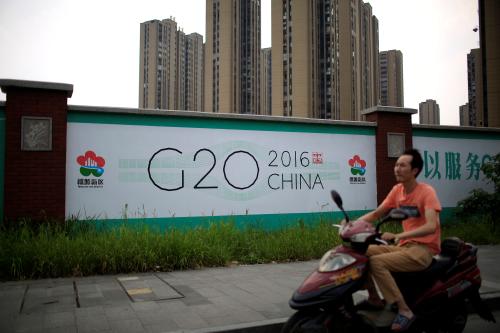Next year is the moment of truth for the Group of 20’s growth agenda. The leading rich and developing nations that comprise the G-20 made 1,000 structural reform commitments back in 2014 with the goal of raising G-20 GDP by 2 percent by 2018. Instead of being 2 percent bigger, GDP is forecast to be more than 3 percent smaller, relative to the October 2013 baseline. With the commitment period soon to expire, the question for Argentina’s 2018 host year is: what next?
Some of the shortfall is the G-20’s fault. Countries have implemented less than half of their commitments from 2014. Almost a quarter have been abandoned altogether, including some of those with the biggest growth-impact, such as President Barack Obama’s immigration reform package.
But the G-20 is not entirely to blame. As governments change, so do their commitments. The October 2013 baseline that underpinned the growth target has also worsened considerably, resulting in a downward revision in 2016 by a full percentage point. While some commitments have been dropped, the group has been busy adding, and implementing, new commitments to replace the old ones.
This creates a predicament for Argentina’s host year in 2018. Should it admit the shortfall, scrap the process, and create a new growth agenda? Or should it maintain continuity and extend the deadline, even though the process has struggled to meet its targets? Neither option is particularly appealing.
The G-20 is developing a nasty habit of “process-churn.” In recent years, it has announced action plans, employment plans, growth strategies, investment strategies, and fiscal strategies on anti-corruption, energy efficiency, financial inclusion, remittance flows, and the list goes on. Many of these initiatives don’t last long, often unpinned by overlapping commitments. The group’s latest initiative—the Enhanced Structural Reform Agenda—is too broad and vague for effective comparability, with 48 guiding principles across nine priority areas.
The G-20 needs continuity to remain credible. Extending its growth agenda and target beyond 2018 is a good way of achieving this. The group has already quietly dropped the October 2013 baseline, measuring instead the growth impact of its reforms. This makes sense and provides a better measure of the G-20’s progress. But given progress has been slow, Argentina will need to do something to revitalize the process and increase ambition.
Competition reform, I argue, provides a solution. Reforms to boost competition within G-20 economies are an existing theme of the growth agenda, so it provides the much-needed continuity. But while reforms on competition have been the largest contributor to the growth target, they have also made up the smallest number of commitments.
Make no mistake: G-20 economies have a significant competition problem, in that there’s not enough of it. Market concentration increased 38 percent in the United States over the 15 years to 2012. More than half of Australia’s markets are concentrated. The family-owned Chaebol conglomerates in South Korea are wreaking economic and political havoc. The “third arrow” of Japanese Prime Minister Shinzo Abe’s economic policies is still largely in its quiver. Canada is struggling on telecommunications reform. Uncompetitive state-owned enterprises are an albatross around Chinese President Xi Jinping’s neck.
Weak competition is a challenge that touches every G-20 country. It has been linked to rising inequality, weak investment, low innovation, poor wage growth, higher prices, and declining productivity. Weak competition is ripe for a strong push. Delivering coordinated commitments to boost competition and to review national competition policies to achieve a postponed G-20 growth target will promote continuity, credibility, and, above all, growth.
But some will question whether the G-20 can really influence domestic competition reform. What could the Argentinian host year actually deliver?
There are reasons to be skeptical. Competition reforms are very country-specific. They are often ill-defined, long-run processes that challenge deeply-vested political interests and test the political capital of even the most popular politicians. Would countries really do anything differently because of the G-20?
Yes, they would. My research in interviewing more than 50 leaders, central bank governors, finance ministers, and officials from across G-20 countries suggests that the group can, and does, influence domestic structural policies. However, this influence shouldn’t be overstated. While it’s wrong to say it has no influence at all, it’s also wrong to say that the G-20 drives domestic structural reform agendas.
Instead, the G-20 helps policymakers to sell difficult reforms domestically, particularly in small and medium-sized economies, by pointing to a global economic consensus. The group can help shift a country’s priorities. It can give policymakers new ideas, create pressure for the timely implementation of commitments, and be used to leverage domestic legislatures. The G-20 influences how policymakers think, build consensus, and engage in peer-to-peer learning on best-practice policies and approaches to implementation.
Most importantly, having G-20 countries undertake structural reform together results in a whole that is greater than the sum of its parts. Through positive spillovers, the overall benefit to G-20 GDP from undertaking structural reforms can be 25 percent larger if they work together, according to the International Monetary Fund and the OECD. Coordination makes structural reform both politically easier and economically more powerful.
The Argentinian host year needs continuity, but a mere re-branding of the growth agenda is not good enough. As the Argentinian proverb goes: “a monkey dressed in silk is a monkey no less.” Next year is Argentina’s opportunity to revitalize the G-20, and its reformist, President Mauricio Macri, is the person to do it.
The Brookings Institution is committed to quality, independence, and impact.
We are supported by a diverse array of funders. In line with our values and policies, each Brookings publication represents the sole views of its author(s).







Commentary
The G-20’s growth agenda is up for renewal—Why it should center on competition reform
December 19, 2017